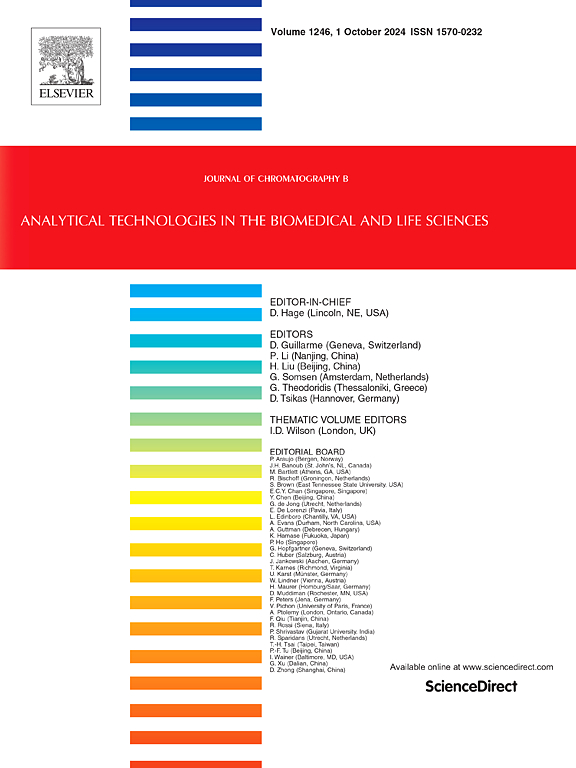Novel GC MS/MS method for bioanalysis of pyrroloquinoline quinone, a potential cognitive enhancer in mice brains
IF 2.8
3区 医学
Q2 BIOCHEMICAL RESEARCH METHODS
引用次数: 0
Abstract
Phenolic compounds have neuroprotective effect in diseases of cognitive impairment. Pyrroloquinoline quinone (PQQ), an aromatic water-soluble quinone enhances cognitive function in-vivo as previously demonstrated by our research group. In an attempt to comprehend the mechanism of action, development of a bioanalytical method for PQQ in brain matrix was essential to investigate blood-brain barrier (BBB) permeability for the drug and/or its metabolites. This study documents a novel fast GCMS/MS method for bioanalysis of PQQ in mice brains following a novel derivatization reaction of this drug. A simple extraction methodology using a single solvent highlights sustainability and greenness of our sample preparation protocol. Method validation and quantitative analysis of PQQ as an intact molecule in mice brain homogenates was done using novel qualifier and quantifier ions of the silylated drug for the first time. We report BBB permeation to PQQ in an induced neuroinflammation mouse model in addition to its sulfate metabolite following intraperitoneal injection. Interestingly, PQQ was detected in brains of control mice on standard diet containing soybeans. In silico prediction suggests the involvement of P-gp in active transport of PQQ across BBB where the drug appears to be is an excellent substrate and inhibitor. Pharmacokinetic analysis in brain revealed tmax as 2 h. Our optimized extraction method, as well as the GC–MS/MS method can be used to quantify levels of PQQ in various matrices opening the door to many other studies on this polyphenol. Moreover, we recommend the use of PQQ as a co-treatment in cognitive impairment diseases.
求助全文
约1分钟内获得全文
求助全文
来源期刊

Journal of Chromatography B
医学-分析化学
CiteScore
5.60
自引率
3.30%
发文量
306
审稿时长
44 days
期刊介绍:
The Journal of Chromatography B publishes papers on developments in separation science relevant to biology and biomedical research including both fundamental advances and applications. Analytical techniques which may be considered include the various facets of chromatography, electrophoresis and related methods, affinity and immunoaffinity-based methodologies, hyphenated and other multi-dimensional techniques, and microanalytical approaches. The journal also considers articles reporting developments in sample preparation, detection techniques including mass spectrometry, and data handling and analysis.
Developments related to preparative separations for the isolation and purification of components of biological systems may be published, including chromatographic and electrophoretic methods, affinity separations, field flow fractionation and other preparative approaches.
Applications to the analysis of biological systems and samples will be considered when the analytical science contains a significant element of novelty, e.g. a new approach to the separation of a compound, novel combination of analytical techniques, or significantly improved analytical performance.
 求助内容:
求助内容: 应助结果提醒方式:
应助结果提醒方式:


